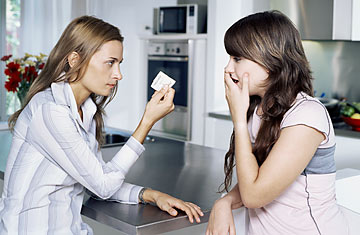
Girls can score just as many times as boys if they want to. I've gone to bed with nine boys in the past two years. It's a natural thing, a nice thing and a nice high. It sure can clear up the blues.
—Mimi, 18, a June graduate of Tenafly (N.J.) High School
I'm still a virgin. My friends last year blamed it on the fact that I was the youngest girl on campus. But I can't see having intercourse unless it's part of a tight emotional bond. My father has influenced me, but the fact that he is a minister has nothing to do with it. The church is not a stronghold against sex any more.
—Amanda, 16, a junior at Shimer College, Mount Carroll, Ill.
THEY could hardly be more unlike, Mimi and Amanda.*Yet both are representative of American teen-agers in 1972. Though Amandas predominate among the nation's boys and girls between 13 and 19, there are enough Mimis so that many parents are alarmed. Even some of the teen-agers themselves, especially those in college, are uneasy about their almost unlimited new sexual license. Along with a heady sense of freedom, it causes, they find, a sometimes unwelcome sense of pressure to take advantage of it. 'I'm starting to feel the same way about getting laid as I did about getting into college," Dustin Hoffman confessed in The Graduate. A Columbia University psychiatrist reports that students come to him to find out what is wrong with them if they are not having intercourse. "My virginity was such a burden to me that I just went out to get rid of it," a junior at the University of Vermont revealed to a Boston sex counselor. "On a trip to Greece, I found any old Greek and did it so it wouldn't be an issue any more."
Was her trip necessary? Is there really a notable increase in teen-age sex? Foolproof statistics about sexual habits are hard to come by, but a recent survey prepared for the Nixon-appointed commission on population seems to offer reasonably reliable figures. Of 4,611 unmarried black and white girls living at home or in dormitories in 1971, more than 46% had lost their virginity by age 20, according to Johns Hopkins Demographers Melvin Zelnik and John Kantner (TIME, May 22). Comparison with previous generations is difficult because earlier studies are incomplete; Alfred Kinsey, for example, author of the first large-scale studies of sexual behavior, did not include blacks in his statistics. However, Kinsey's 1953 survey of some 5,600 white women disclosed that 3% were nonvirgins at age 15, and 23% had had premarital intercourse by the time they were 21. By contrast, Zelnik and Kantner report that of the 3,132 whites in their sample, 11% of the 15-year-olds were nonvirgins, and 40% of all the girls had lost their virginity by the age of 20. In short, youth's sexual revolution is not just franker talk and greater openness; more teenagers, and especially younger ones, are apparently having intercourse, at least occasionally.
Another indication of the reality of youthful sex is the rising incidence of VD, which has now reached epidemic proportions in high schools and colleges. After the ordinary cold, syphilis and gonorrhea are the most common infectious diseases among young people, outranking all cases of hepatitis, measles, mumps, scarlet fever, strep throat and tuberculosis put together. In 1970 there were at least
